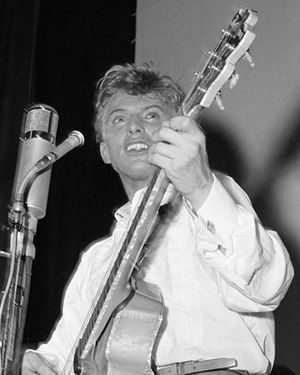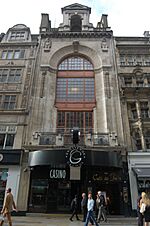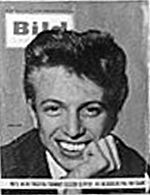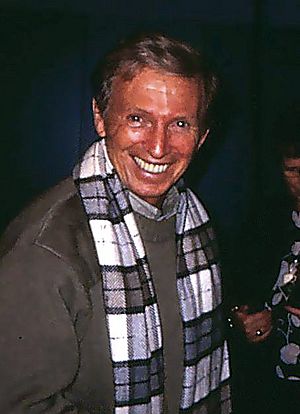Tommy Steele facts for kids
Quick facts for kids
Tommy Steele
|
|
|---|---|

Steele performing in Stockholm in 1957
|
|
| Background information | |
| Birth name | Thomas Hicks |
| Born | 17 December 1936 London, England |
| Genres | Rock and roll, skiffle |
| Occupation(s) | Singer, actor |
| Instruments | Vocals, guitar, banjo |
| Years active | 1956–present |
| Labels | Decca, Columbia, RCA Victor |
| Associated acts | The Steelmen |
Sir Thomas Hicks (born 17 December 1936), known as Tommy Steele, is an English entertainer. He is famous for being Britain's first teen idol and rock and roll star.
Tommy Steele was discovered at the 2i's Coffee Bar in Soho, London. He quickly released hit songs like "Rock with the Caveman" (1956). His song "Singing the Blues" (1957) even reached number one. His journey to fame was shown in the film The Tommy Steele Story (1957). The movie's soundtrack was the first British album to top the UK Albums Chart.
With help from Lionel Bart and Mike Pratt, Tommy Steele won an Ivor Novello Award in 1958. This was for "A Handful of Songs," named the Most Outstanding Song of the Year. He also starred in other musical films. These included The Duke Wore Jeans (1958) and Tommy the Toreador (1959). The song "Little White Bull" came from Tommy the Toreador and became a hit.
In the 1960s, Steele moved away from rock and roll. He became a versatile entertainer. He played the main role of Kipps in Half a Sixpence on stage in London's West End and on Broadway. He also played this role in the 1967 film version. As an actor, he appeared in films like The Happiest Millionaire (1967) and Finian's Rainbow (1968). He also led several West End shows of Singin' in the Rain.
Tommy Steele is also an author and a sculptor. He is still active in entertainment today. He was made a knight in 2020 for his work in entertainment and charity. In 2021, he received the Freedom of the City of London.
Contents
Early Life and Dreams
Tommy Steele was born Thomas Hicks in Bermondsey, London, in 1936. His father, Thomas Walter Hicks, was a racing tipster. His mother, Elizabeth "Betty" Ellen Bennett, worked in a factory.
When he was a child, Steele spent time in the hospital. He dreamed of becoming a star performer. His parents took him to the London Palladium, which inspired him. In 1952, at age 15, Steele joined the Merchant Navy. He worked on the Cunard shipping line.
Steele went to Bacon's College in Rotherhithe, south London. His family's full name, Still-Hicks, helped him choose his stage name, Tommy Steele.
Music Career
Becoming a Rock and Roll Star
While working as a merchant seaman, Steele learned to play guitar. He started performing country and calypso music. He was especially inspired by Hank Williams.
In the summer of 1956, Steele met writer Lionel Bart and actor Mike Pratt. They met at a party in Soho. The three began writing songs together. They formed a group called the Cavemen. Steele started playing in Soho bars, often with the Cavemen. He sang songs like "Blue Suede Shoes" and "Heartbreak Hotel".
A photographer named John Kennedy saw Steele perform. This was at the 2i's Coffee Bar. Within two weeks, Steele got a record deal with Decca. Kennedy and manager Larry Parnes created a plan to get Steele noticed. Steele performed at a special party, which led to his first national newspaper story. Soon, Steele was the main act in many shows.
Steele's first song, "Rock with the Caveman," was one of Britain's first rock and roll hits. It reached number 13 on the charts in November 1956. He appeared on TV for the first time to promote the song. He quickly became a national teen idol. People called him "Britain's Elvis" because he was so successful. Teenage fans would get very excited at his live shows. His first album, Tommy Steele Stage Show, was recorded at a concert in London. It came out in March 1957.
Steele's third song, "Singing the Blues," reached number 1 in January 1957. Tommy Steele was one of the first British pop stars to have lots of merchandise. There were sweaters, shoes, and toy guitars with his name on them. Just a few months after his first hit, a film about his life was made. The Tommy Steele Story (1957) had twelve new songs. These songs were written quickly by Steele, Bart, and Pratt. The film's soundtrack was the first UK number one album by a British artist. The hit song "A Handful of Songs" won an award in 1958. By the end of 1957, Steele was earning a lot of money. He bought a house for his parents in South London.
Steele appeared on the BBC show Six-Five Special. He performed at the Royal Albert Hall in April 1957. He was also the top act at the Royal Variety Performance in November 1957.
In March 1958, Steele starred in his second film, The Duke Wore Jeans. He played two roles in the movie. The film's soundtrack also topped the UK Albums Chart. In May 1958, Steele had to go to the hospital. Fans got too excited at a concert in Dundee. After this, Steele performed fewer concerts. He started working more in the theatre. He continued to record rock and roll songs in 1958 and 1959. He had hits with covers of American songs. These included "Come On, Let's Go" and "Tallahassee Lassie". In September 1958, he appeared on Oh Boy!. This TV show featured new British rock and roll stars like Cliff Richard.
In August 1959, Steele visited Moscow for three days of concerts. His film The Tommy Steele Story was shown at the Kremlin. In his first color film, Tommy the Toreador (1959), Steele was praised for his performance. A popular song from the film, "Little White Bull," became a favorite for children. It was released to help a cancer research center for children.
Tommy Steele is seen as Britain's first rock and roll star. His early songs have been described as "charming and simple." In 2009, a collection of his greatest hits, The Very Best of Tommy Steele, reached the Top 40 in the UK. This was his first time on the UK chart in over 46 years.
Acting Career
From Pop Star to Stage and Screen
As more British music talent appeared in the 1950s and 1960s, Steele moved into stage and film musicals. He left behind his pop star image. In 1957, he was voted the seventh most popular actor in British cinemas.
In 1960, after a tour in Australia, he received two offers. One was to star in the play Billy Liar. The other was to join the Old Vic Company, a famous theatre group. He chose the Old Vic.
In London's West End, he appeared in She Stoops to Conquer. He also played the main role in Hans Christian Andersen. In films, he played his stage role again in Half a Sixpence. He also starred in The Happiest Millionaire and Finian's Rainbow. In Finian's Rainbow, he played Og, a leprechaun who becomes human. He acted alongside Petula Clark and Fred Astaire. In 1968, he was voted the fourth most popular star in British cinemas. The next year, he starred with Stanley Baker in the film Where's Jack?
In April 1971, Steele had his own show called Meet Me in London. It started in Las Vegas before coming to London's Adelphi Theatre.
In 1978, Steele performed in a TV movie. It was a version of Gilbert and Sullivan's The Yeomen of the Guard. He sang the role of the jester Jack Point.
In 1983, Steele directed and starred in the stage show Singin' in the Rain. This was at the London Palladium. In 1991, he toured with Some Like It Hot. This was a stage version of the famous film. In 2003, after a break, he toured as Ebenezer Scrooge in Scrooge: The Musical. This show was based on the 1970 film Scrooge. He brought this show to the London Palladium for Christmas 2005. It toured for the next ten years. In 2008, at age 71, Steele toured in the main role of the musical Doctor Dolittle.
In 2015, Steele began touring as Glenn Miller in a new stage show. This was The Glenn Miller Story. It toured the UK twice before a summer season at the London Coliseum.
He was the subject of This Is Your Life in 1958. In December 2019, he hosted a 'Magic of the Musicals' event. He talked about his favorite musical theatre film routines.
Other Talents: Sculptor and Author
Sculpting and Writing
Tommy Steele is also a respected sculptor. Four of his major sculptures have been shown publicly. Bermondsey Boy was at Rotherhithe Town Hall in London. It was stolen in 1998. Eleanor Rigby is a sculpture he made and gave to the City of Liverpool. It honors the Beatles. It stands in Stanley Street, Liverpool, near the Cavern Club. Union, which shows two rugby players, is at Twickenham Stadium. Trinity was designed for the Bermondsey docklands area. It stood outside the Trinity building. When Steele lived in Petersham, Surrey, his life-sized sculpture of Charlie Chaplin as "The Tramp" was outside his home. He is also a skilled artist and has shown his work at the Royal Academy.
In 1981, Steele wrote a novel called The Final Run. It was about World War II and the Dunkirk evacuation.
He also wrote a children's novel called Quincy. It was about a toy trying to save himself and other toys from a furnace. This book came out in 1981. It was based on his own TV film, Quincy's Quest, from 1979. In the film, Steele played Quincy.
Steele co-wrote many of his early songs with Lionel Bart and Mike Pratt. From 1958 onwards, he used the pen name Jimmy Bennett.
In November 2019, Steele received a Lifetime Achievement Award. This was from the British Music Hall Society. Many people honored his long career in show business.
In May 2020, Steele announced a new project called Breakheart. It was an audio thriller with seven episodes. Steele wrote it, and it was set during the Second World War. A new episode was released each day for a week. He also released a festive story called The Christmas Mystery of Muchhope.
In June 2021, his official biography, A Life in the Spotlight, was published. It was written by Sebastian Lassandro.
Personal Life
Tommy Steele and Winifred Ann Donoghue (born 1936) got married. They married at St Patrick's Catholic Church, Soho Square, London, in spring 1960.
The couple has one daughter.
Awards and Recognition
In 2019, Steele was given the Freedom of the City of London. The ceremony was delayed until July 2021 due to the COVID-19 pandemic.
In 1979, he was made an Officer of the Order of the British Empire (OBE). This was for his work as an entertainer and actor. He was made a knight in 2020. This honor was for his services to entertainment and charity.
Legacy and Influence
Tommy Steele's fame as a teen idol was often made fun of in his time. On his album The Best of Sellers (1958), Peter Sellers played a rock and roll star named "Mr. Iron." Steele's rise to fame was also shown in the 1958 musical Expresso Bongo. The 1959 film version starred Cliff Richard.
There is a London Borough of Southwark blue plaque on Nickleby House. It is in the Dickens Estate in Bermondsey. This plaque remembers Tommy Steele.
Discography
Filmography
- Kill Me Tomorrow (1957)
- The Tommy Steele Story (1957)
- The Duke Wore Jeans (1958)
- Tommy the Toreador (1959)
- Light Up the Sky! (US: Skywatch, 1960)
- It's All Happening (US: The Dream Maker, 1963)
- The Happiest Millionaire (1967)
- Half a Sixpence (1967)
- Finian's Rainbow (1968)
- Where's Jack? (1969)
- Twelfth Night (TV, 1970)
- Tommy Steele in Search of Charlie Chaplin (TV, 1971)
- The Yeomen of the Guard (TV, 1978)
- Quincy's Quest (TV, 1979)
See also
 In Spanish: Tommy Steele para niños
In Spanish: Tommy Steele para niños




